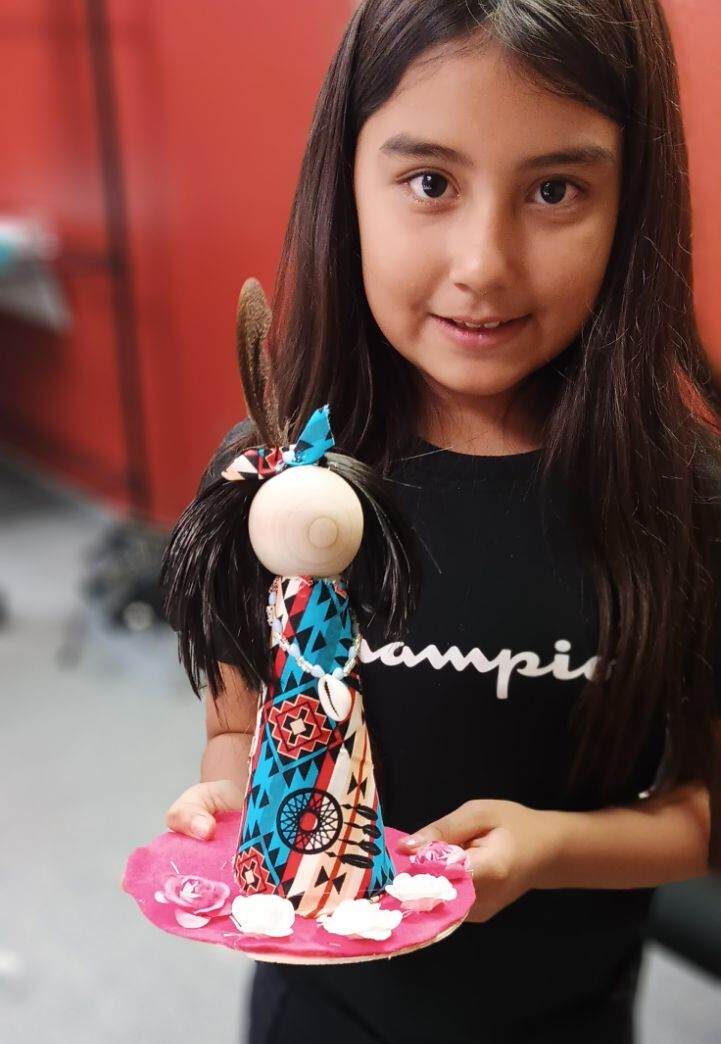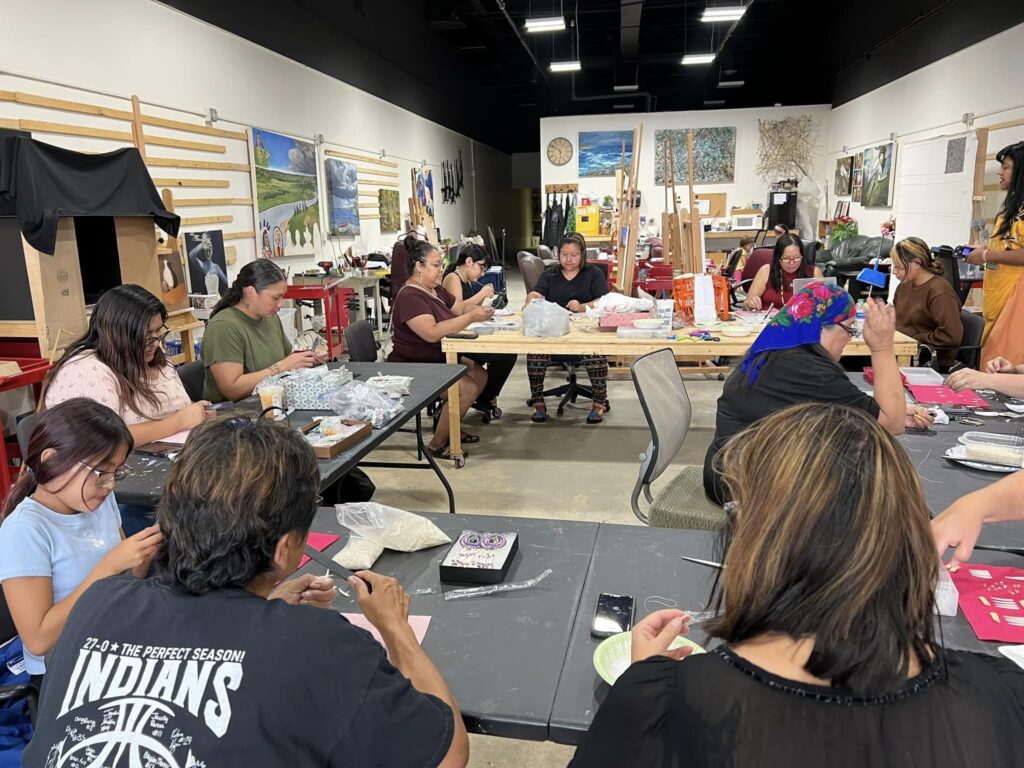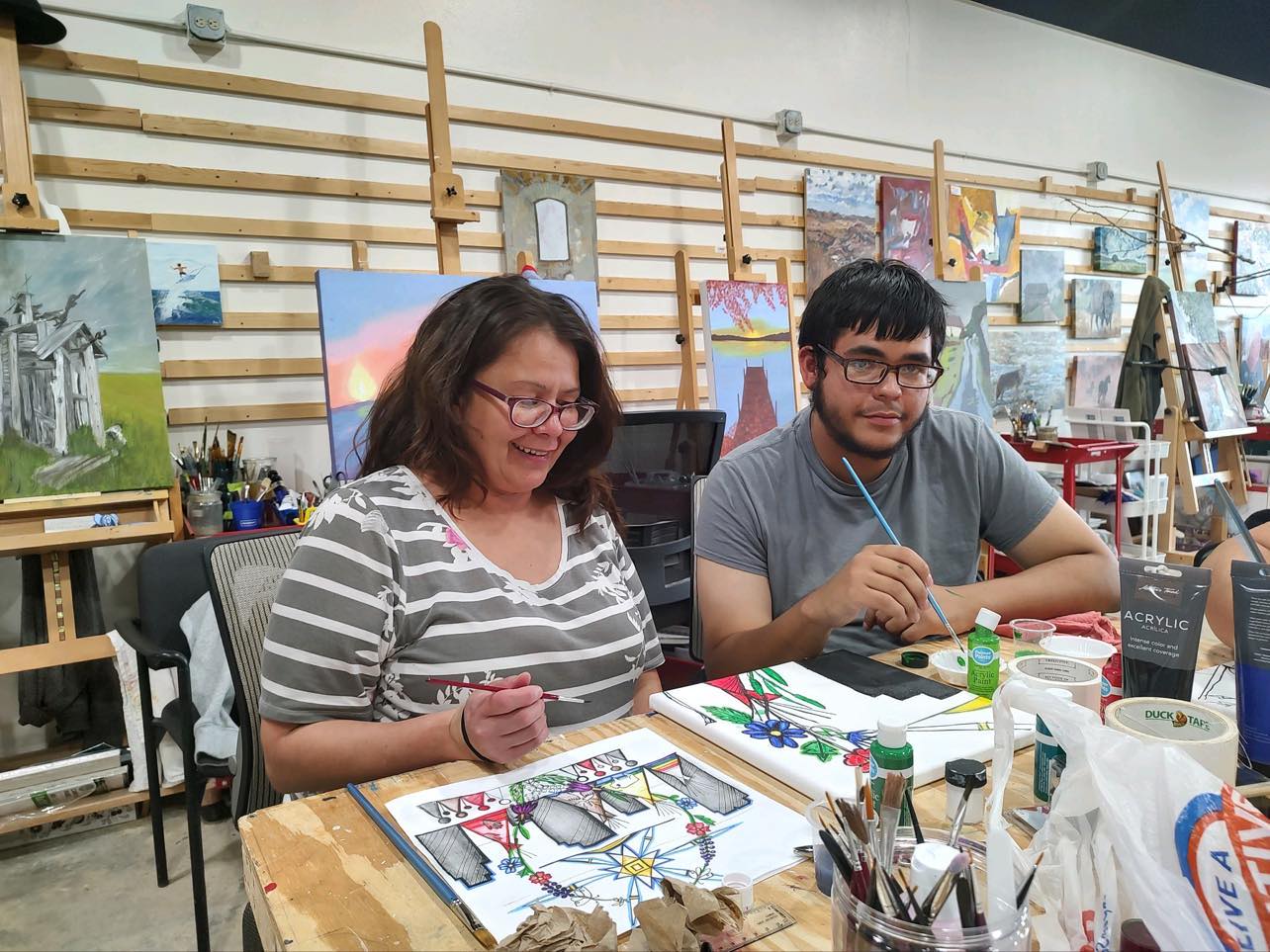Community is everything, and that’s especially true for Indigenous peoples. Moving to a larger city like Bismarck, North Dakota, and its suburb, Mandan, can be jarring for Native Americans coming from more rural areas. That’s where Sacred Pipe Resource Center comes in. As a home away from home for many Indigenous peoples who have moved to the area, SPRC provides opportunities for connection, community, and collective caretaking by addressing resource gaps and giving space for art workshops.
“I went to a sewing class where we could make jingle dresses or a fancy shawl dress. I have two daughters, ages 10 and 8, and we’re enrolled with the Standing Rock Sioux tribe, but we’re Shoshone-Bannock and Hunkpapa Lakota. Me and my family grew up dancing, so I’ve been doing that with my girls,” says Crystal Black Cloud, who comes to workshops when her work schedule allows.

Valerie Sisquerios and her family moved to the Bismarck area in August 2022. They were previously living in the reservation, so it took some time for her young daughter to adjust, especially since she was changing schools and entering middle school after being in pandemic lockdown. To keep connected to their culture, mom and daughter started to attend as many of the workshops as they could together.
“The first class we went to was a dentalium earring class,” Sisquerios says. Dentalium, the tooth and tusk shells of marine mollusks, are used for jewelry and historically were traded from the West Coast to the Plains. “Since then, there’s been a number of art classes available, so we’ve gone to nearly all of them. There was a frame painting class that was really soothing, and another time, we made welcome signs that you could display outside your door. We wrote greetings in our native languages. I’m half Lakota and half Paiute, so I used both greetings. Then my daughter is also Hispanic, so she just did Hola on hers.”
One of the classes Black Cloud, Sisquerios and her daughter attended was taught by Leah McCloud. McCloud incorporated the teachings of the four directions into workshops for making a series of miigis (cowrie) shell dolls.

“I moved to Bismarck eight years ago, but while I was living on the reservation, we learned our culture and traditions from the aunties,” McCloud says. “One thing that always intrigued me was the four directions in the medicine wheel. Each direction represents a stage of life and the medicines, and there are all these different meanings and teachings within that direction.”
As McCloud reflected back on her life and her aunties’ teachings, the two came together in her mind as a healing practice. Making dolls that focus on each of the four directions and the challenges of that point in life, combined with natural medicines, is a soothing spiritual practice that she wanted to share with the wider SPRC community.
“The eastern doll represents the infant stage and new beginnings. It has tobacco and two feathers, and even though it has no face, it still tells me something that I remembered at that age of development,” McCloud says. “In that direction of my life, things were challenging within the home and with myself spiritually. People can say what they want, but I think Native people are just really open to the spirit world.”
The next in the series of miigis shell doll workshops focused on the southern direction, which is the age of becoming a teenager.
“In this direction, I had so many questions, like what am I supposed to do and who am I supposed to be? This stage is where my aunties would give us instructions on the sweat lodge and our roles in ceremonies,” McCloud adds. “It was in this workshop at Sacred Pipe that I brought in the cedar. I shared that the teaching with cedar means that we should seek out our elders to help us determine who we are to become.”
Even beyond their cultural significance, McCloud wanted the miigis shell dolls to help women reconnect with themselves.
“Each doll helped me remember certain things about who I am. As we get older or as we become mothers and wives, we kind of forget who we are because we’re so busy living that life. I wanted to remember who Leah is,” she says.
However, the class wasn’t limited to wives and mothers—there were women of all ages and little girls there too. For McCloud, seeing how each person was inspired to decorate their dolls was moving.
“One lady put gems all over. And she said, ‘For some reason, I remembered when I was a little girl going for a walk and picking up rocks, and I used to love collecting rocks.’ And I just love the little girls. They made their dolls with flowers all over them and how they’re seeing themselves as beautiful and just enjoying life and nature,” McCloud adds.
Sisquerios has noticed her daughter becoming more creative and confident with each workshop at Sacred Pipe.




“It’s important for me to keep her exposed to Indigenous cultural events, especially since we’re living in an urban area. She runs up to the building and is so comfortable with everybody, which is amazing,” Sisquerios began. “She used to be super outgoing all the time and would talk to everybody, but when the pandemic hit, we were living on the reservation and we were already in a very secluded area, and then she couldn’t even leave the house. She got pretty shy, and that really affected her. So when we moved to Bismarck, and she started going to her school, it took her a long time to open up. She’d never been to a public school before, so she was having a lot of anxiety, especially with it being her first year of middle school. So Sacred Pipe really helped bring her out of her shell. If you talk to anyone at Sacred Pipe, they’d never know she had this issue.”
“My girls enjoyed it, and it was nice to meet people. My girls liked putting the dolls together,” Black Cloud adds.
McCloud appreciates how Sacred Pipe is always doing something to connect the community.
“When I was teaching my classes, there were three other sessions going on. One was a group of ladies who were doing something with medicine and cooking, and because of the open-door policy, a young mom and her little kids came off the streets and came in and ate,” McCloud says. “Just being open to the community no matter if you’re there for a class or food or what, that’s the kind of environment there.”
